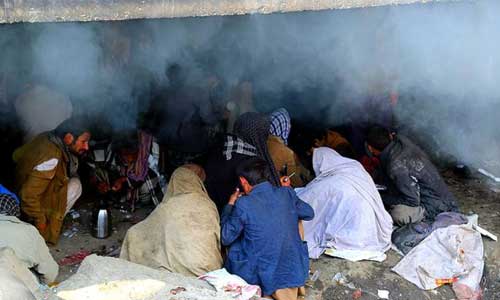Although there is no accurate reports about level of addiction in the country, it is said that around three million people are addicted in Afghanistan while a large number of them have no specific shelter, especially in this freezing weather. According to a media report which was quoted from ministry of health, about 8 thousand shelterless addicts are only in the capital city of Kabul while they have no income other than earning their addiction and food expenses through thievery. Now, if we calculate 8 thousand thieves in a single city with at least 8 thousand thieveries in 24 hours, there will be no tranquility or social security in the city, especially in the area located close to addicts’ area. Even, it is said that the people who live around the area of addicts are willing to move from this part of the city. Also the houses located around this are not easily rented. Accordingly, the neighboring families do not easily dare to send their children to parks, schools, educational centers due to presence of drug users. These families and children are isolated at their homes due to presence of addicts at their surroundings.
In addition to this, the presence of drug users in different parts of the city has normalized the obscenity of additions in the society and so the use of opium, cannabis and other types of addictive substances have become rampant everywhere in the city or in the country. These addicts usually reside in Parks, sidewalks, under bridges and anywhere in the city. For example, Pole-Sothta (big bridge) and its soundings are famously considered as area of addicts in Kabul, the capital city of the country. This place which hosts thousands of addicts also connects west of Kabul to the downtown of the city. Every moment thousands of people cross from this crowded point while bearing smell of drugs, cannabis and huge amount of offscourings produced by the drug users.
In this area, even the dogs are addicted. Therefore, the households living around the area not only complain about environmental pollution but also complain about insecurity in this area. There are no family who has no experience about addict’s thievery and annoyances. In short, a large number of people has really lost their psychic security while the problem are increasing.
Despite this chronic condition, there seems no plans to clean the cities and environment from presence of drug users and nor the government has capacity and facilities to treat them. If the current condition continues, it not only increases the level of additions in the country but also the territory of addicts will expand in the city and also in the country. As abovementioned, the addicted people have no income other than earning the expenses of drugs and foods through thievery. So, if we have 3 million addicts, we would have three million thieves in the country. Even, if there were no terrorists and no organized criminal groups, 3 million thieves in the country or 8 thousand thieves in the Kabul, would be enough to destroy the tranquility and security in this city.
Given the above painful facts and realities, we must accept that drug addiction is one of the most important problems which challenge everyone in the country, especially in Kabul city. In the past, drug addiction was mostly limited to men who spent years as laborers or war refugees in neighboring countries, but in recent years, as above explained, it has been normalized and involved thousands of women and children in the country. therefore, addition is a very dangerous phenomenon for every individuals and society, but it will be more dangerous when women are engaged in addictions. As women have a very specific role in family and society, they can seriously endanger the health and dynamics of society and they can rapidly pave the way for devastation of a society. Given the increasing figures and statistics of women addiction, it became one of the ambiguous and dangerous phenomena in Afghanistan.
According to experts, opium cultivation, administrative corruption, illiteracy, unemployment, psychological pressure and traveling are of the main factors of men and women addiction. In addition, lack of access to health centers and a positive view to opium as medicine, child sexual abuse, rape (individual and group), all kinds of domestic violence, poverty and deprivation, dual attitude towards family children (girl and boy) which is very common in Afghanistan, HIV or AIDS caused by prostitution, easy access to drugs, encouragement or being forced by addicted family members or friends are called some of the main factors of female addiction in Afghanistan. It said that some of husbands deliberately make their wives become addicted for several purposes such as freely use of drugs at home, prevents from separation or divorce. Thus, they intentionally addict their wives so as to pave the way for sex works and through which gain their drug and other expenses.
In general, the consequence and risk of addiction are limited to aforementioned issues but also other problems such as increasing violence, prostitution and even the disintegration of families. Psychologically, if we assume 3 million addicts in the country, these addicted people have also sisters, daughters, mothers, spouse. So, how many Afghans will psychologically suffer from these issues? Certainly, a large percentage of the Afghan people are directly and indirectly affected by this destructive and devastating phenomenon. Therefore, the phenomena of addiction must not be belittled in the country, especially in Kabul.
Home » Opinion » A Glimpse at Territory of Addicts in Kabul City
A Glimpse at Territory of Addicts in Kabul City
| Mohammad Zahir Akbari

